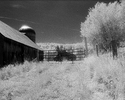Has anyone experiemented with making fixer from onions? Perhaps not the simple "mix and fix" solution travelers might seek, but I recalled reading that onions are toxic to dogs and cats due to their thiosulfate content.
This article confirms that there are two thiosulfate compounds in onions and garlic -- sodium n-propyl thiosulfate and sodium 2-propenyl thiosulfate -- at levels that cause hemolytic anemia in dogs and cats (and probably other mammals that aren't primates).
I'd be amazed if it weren't possible to convert these two compounds to sodium thiosulfate, likely by the same method used to make n-acetyl p-aminophenl (acetaminophen aka paracetamol) into p-aminophenol. What I don't know is how much thiosulfate is present in onions or garlic, or how to extract it separate it from other soluble substances. It's probably not a simple as making onion soup.
What I'd hypothesize as a starting point would be to extract the juice of onions, or boil them, finely divided, in water, add sodium or potassium hydroxide to cleave off the organic group from the thiosulfate (it seems the sodium is on the other end of the thiosulfate group, and in any case will separate in solution due to ionization). What I lack is knowledge of how then to separate the sodium thiosulfate from the organic. A hydrophobic organic solvent, perhaps, like toluene? Or perhaps the organic (propane or propene?) will simply evaporate off, being insoluble in water? Once the organic fraction is removed, it should be easy to neutralize the solution with a mild acid and evaporate the water to give a mix of sodium thiosulfate and the sodium salt of whatever acid was used.
No, probably not something you can carry out on the the warmer plate of the hotel's coffee machine (especially not the crappy little single-filter ones they have now in American corporate hotels, which don't even have a warmer), but perhaps still a little more accessible than finding a pool store and buying several kilos of chlorine reducer.





 No, but I chopped up a whole bunch of shallots and soaked them ( skin and all ) in IPA for a few weeks... hoping to see some reversal like @darkroomexperimenter saw when he developed film with shallots. I wasn't able to reproduce his result.
No, but I chopped up a whole bunch of shallots and soaked them ( skin and all ) in IPA for a few weeks... hoping to see some reversal like @darkroomexperimenter saw when he developed film with shallots. I wasn't able to reproduce his result.
